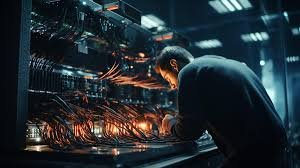
Introduction: Why Everyone’s Talking About smci
Ever notice how certain names in tech suddenly go from being insider buzzwords to front page headlines? That’s exactly what happened with smci. A few years ago, unless you were knee deep in server racks or AI infrastructure, you probably hadn’t even heard of it. Fast-forward to today, and investors, engineers, and even everyday tech enthusiasts can’t stop asking: What’s the deal with smci?
And here’s the thing—smci isn’t just another tech stock. It’s become a symbol of the AI boom, a quiet but critical player powering everything from ChatGPT-like models to hyperscale data centers. Honestly, the more you dig into smci, the more you realize it’s not hype—it’s hardware. Real, tangible, “you can actually touch it” machines that make the magic of AI, cloud, and big data possible.
So let’s unpack the whole story: what smci is, why it matters, where it came from, and what the future might hold.

What is smci? A Quick Background
smci refers to Super Micro Computer, Inc., a company headquartered in San Jose, California. Founded in 1993 by Charles Liang, smci carved its niche in the server and storage solutions market. Instead of chasing consumer gadgets, it went straight for the guts of computing: servers, workstations, blades, storage systems, networking gear, and advanced AI platforms.
From the beginning, smci emphasized three things:
-
Customization – Customers could design servers tailored to their workloads.
-
Energy Efficiency – Way before “green data centers” became trendy, smci was engineering for lower power usage.
-
Speed to Market – smci has a reputation for getting new technologies into production faster than bigger, slower-moving competitors like Dell or HP.
That nimbleness is exactly why smci is suddenly at the center of today’s AI explosion.
Why smci Matters in 2025
Let’s cut to the chase: AI models are hungry—really, really hungry. Training a large language model (LLM) isn’t like running a spreadsheet; it’s like feeding a small country. The compute requirements are massive, and that’s where smci shines.
-
AI Training Clusters: smci builds GPU-heavy server systems that power companies like OpenAI, Anthropic, and Meta.
-
Cloud Infrastructure: Hyperscale providers (think AWS, Google Cloud, Azure) buy smci gear because it’s modular, customizable, and available faster than other suppliers.
-
Enterprise Edge Computing: smci isn’t just for giant data centers. Its flexible servers are increasingly used by enterprises processing data at the edge (like autonomous driving).
Here’s a quick snapshot of why smci is dominating the headlines:
| Feature | Why It Matters |
|---|---|
| GPU-Optimized Servers | Built for AI workloads with NVIDIA H100s and AMD MI300s. |
| Faster Deployment | smci gets systems to market months faster than bigger OEMs. |
| Sustainability | Green computing lowers costs for data centers. |
| Scalability | Configurations range from single servers to mega-clusters. |
So when people say “AI boom,” what they often mean is “smci demand boom.”
Case Studies: smci in Action
Let’s make this concrete.
-
ChatGPT’s Backbone
Rumor has it that much of the infrastructure behind generative AI models runs on smci hardware. While NVIDIA gets the headlines for GPUs, smci quietly builds the racks that hold those GPUs. No racks = no training. -
Tesla’s Dojo Training
Tesla’s AI supercomputer, Dojo, leans heavily on optimized servers. While Tesla designs its own chips, smci plays a role in building systems capable of handling such workloads. -
Startups Scaling Fast
A mid-sized AI startup in Silicon Valley shared how smci shaved six months off their go-to-market timeline by delivering a custom GPU server cluster. For a startup, that’s life or death.
smci vs. The Competition
Of course, smci isn’t alone. Dell, HP Enterprise, Lenovo, and others are all in the same space. But here’s where smci pulls ahead:
Pros of smci
-
Faster adoption of bleeding-edge chips (NVIDIA, AMD, Intel).
-
Agile supply chain (less bureaucracy).
-
Strong customer customization.
-
Growing reputation in AI and green computing.
Cons of smci
-
Smaller brand recognition compared to Dell/HP.
-
Higher reliance on GPU demand cycles.
-
Stock volatility (investors know this rollercoaster too well).
Truth be told, smci is like the startup that never stopped acting like a startup—even as it scaled.
The Problems (and Solutions) Facing smci
No company is bulletproof, and smci has its share of challenges:
-
Competition for GPUs: When NVIDIA is sold out, smci can’t build as many systems.
-
Geopolitical Tensions: Supply chain issues (think China/Taiwan chip politics) could cause disruptions.
-
Market Saturation: If AI demand cools, will smci still grow at this pace?
Solutions? smci is already diversifying into liquid cooling tech, enterprise edge deployments, and closer collaborations with chipmakers to guarantee supply.
Myths vs Facts about smci
Let’s bust a few misconceptions:
-
Myth: smci makes GPUs.
-
Fact: Nope. It builds the servers that hold GPUs. Think racks, cooling, motherboards.
-
-
Myth: smci is a “new” company.
-
Fact: Founded in 1993, smci has been in the game for 30+ years.
-
-
Myth: smci only serves tech giants.
-
Fact: Its modular systems also serve mid-market enterprises and startups.
-
Future Outlook for smci
So, what’s next? Three big trends point toward smci continuing its hot streak:
-
AI Everywhere – As industries from healthcare to finance adopt AI, demand for GPU servers won’t slow down anytime soon.
-
Liquid Cooling – With heat becoming the biggest bottleneck in data centers, smci’s liquid-cooled racks could become standard.
-
Global Expansion – smci is aggressively expanding manufacturing outside the U.S. and Asia to de-risk its supply chain.
If you ask me, smci feels less like a bubble stock and more like a company at the center of a tectonic shift.
Practical Takeaways for Readers
-
Investors: smci is high-risk, high-reward. If you believe AI demand will stay hot, it’s worth watching.
-
Tech Professionals: Understanding smci hardware helps you future-proof your skills.
-
Businesses: If you’re scaling AI workloads, smci’s fast turnaround could be your edge.
Expert Perspectives
Gartner analyst Naveen Mishra recently noted: “smci has effectively positioned itself as the fastest mover in AI infrastructure. While competitors are catching up, its first-mover advantage in integrating NVIDIA and AMD GPUs at scale is unmatched.”
Even Jensen Huang, CEO of NVIDIA, casually dropped smci in a keynote: “Our partners like smci enable the world’s AI revolution.”
When industry titans are naming you, you’re not small-time anymore.
FAQs about smci
Q1. What does smci stand for?
smci stands for Super Micro Computer, Inc., a server and storage solutions company.
Q2. Why is smci stock so volatile?
Because it’s closely tied to AI demand and GPU availability. When AI hype spikes, so does smci’s valuation.
Q3. Does smci compete with NVIDIA?
Not directly. smci builds systems that use NVIDIA’s GPUs. They’re more partners than rivals.
Q4. Who are smci’s biggest customers?
Cloud providers, AI labs, research universities, and enterprises deploying AI at scale.
Q5. Is smci only about AI?
No. It also provides servers for storage, cloud computing, and enterprise IT. AI just happens to be its fastest-growing segment.
Q6. How does smci compare to Dell or HP?
smci is more agile, faster to adopt new chips, and highly customizable—though it lacks the global brand reach of Dell/HP.
Q7. Where does smci manufacture its servers?
Mostly in the U.S. and Taiwan, with expansions planned in other regions for supply chain resilience.
Q8. Is smci sustainable?
Yes. Its energy-efficient designs are marketed as “green computing,” which reduces costs and environmental impact.
Q9. Will smci keep growing after the AI boom?
Analysts believe so, especially as edge computing, IoT, and liquid cooling become mainstream.
Q10. Should I invest in smci?
That depends on your risk tolerance. smci is a growth stock tied to the volatile AI cycle. Do your own research before investing.
Conclusion: The smci Story Is Just Beginning
smci may not have the flashy consumer brand of Apple or the global dominance of Microsoft, but in the trenches of AI and cloud infrastructure, it’s the name to know. From nimble beginnings in San Jose to becoming the quiet backbone of the AI revolution, smci has proven that hardware innovation still matters in a software-driven world.
The story of smci is, in many ways, the story of modern computing: fast-moving, high-stakes, and constantly evolving. If you care about where AI and cloud are headed, you can’t afford to ignore smci.


